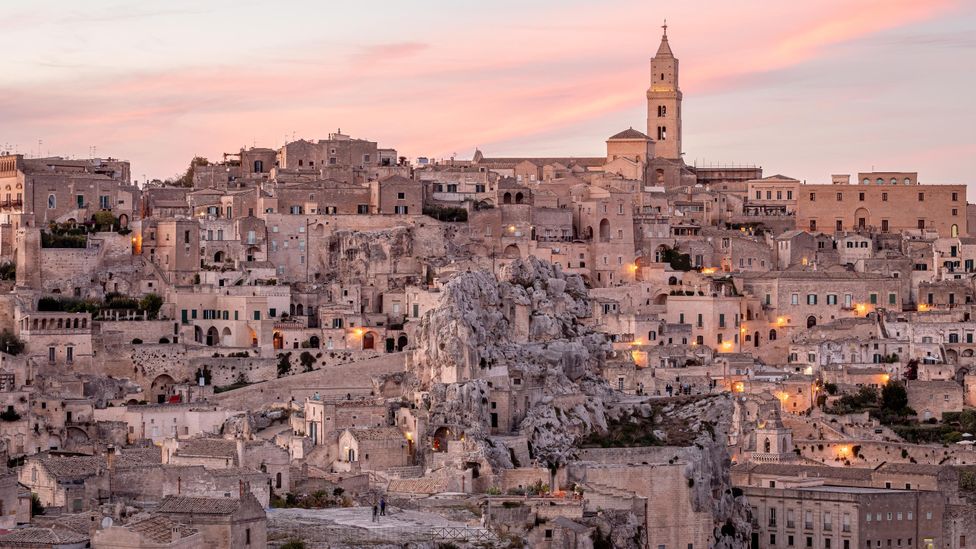Despite once being declared 'a national embarrassment', Matera's ancient stone dwellings and water systems are now renowned as a model for sustainable living.
I
I was having coffee with Antonio Nicoletti in the Piazza Vittorio Veneto in the southern Italian city of Matera, when he recalled how the piazza was abuzz with anticipation in 1991. "When I was much younger than now, this whole area was just a regular paved road, with cars, parking and a few flower beds. One day, when I was 17, one of the flower beds started to collapse," he said.
Nicoletti, now a civil engineer, urban planner and director of the Basilicata Tourism Board, recounted how workers were brought in to see what was happening underground. He and his friends would hang around, fascinated by the goings on. "There was a man wearing scuba gear and carrying an inflatable dinghy who went underground to explore. Just like in a movie," he recalled.
It turned out that the flower bed had been built on top of a giant cistern adjacent to the ancient Sassi, the old cave district of Matera. Inhabited since approximately 850 CE, the Sassidistrictwas famously declared a "vergogna nazionale" (a national embarrassment) by the Italian government in the early 1950s, when it was discovered that residents were living in squalor, without proper access to clean water, electricity or sewage. The Sassi was evacuated, and the 20,000 residents relocated to newly built apartment buildings in the modern suburbs.
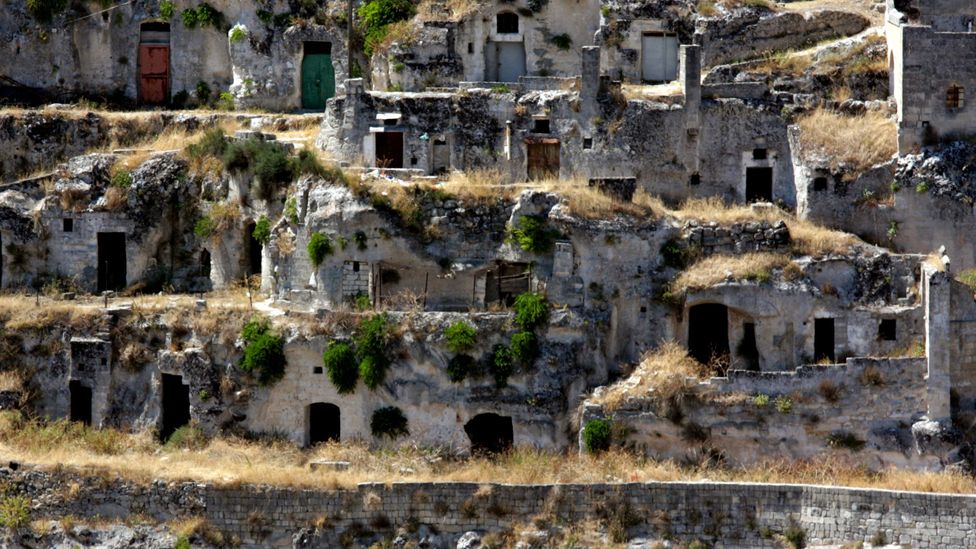
The Sassi district was famously declared a national embarrassment by the Italian government (Credit: Salvatore Tammaro photography/Getty Images)
The rediscovery of the cistern was a shock to many, both in and outside Italy. However, for many Materani – those who had grown up in the Sassi and their descendants – it only reinforced what they already knew: Matera was not a backward place. Before its tragic fall from grace due to poverty, overcrowding and widespread illness, Matera had been a successful, advanced community with an impressive subterranean system of rainwater collection and canalisation.
From the 9th Century, the Sassi was home to a tightly knit community of landowners, artisans and merchants – and, later, peasants and shepherds – who had adapted to life in the largely barren, rocky surroundings. Their stone homes were conducive to cool winters and hot, desert-like summers, and the caves they dug out of the soft limestone behind their homes were ideal for storing food as they kept a constant temperature.
The inhabitants also created a simple but ingenious reservoir system carved out of the stone that collected and filtered rainwater. "For a city, access to watercourses is very important," said Sabrina Centonze, an architect specialising in low-impact housing. "In their absence, Matera exploited spring water and rainwater, collecting them in various types of cisterns that were suited to different purposes."
Waste, wastewater and manure were recycled. The largely self-sufficient community grew its own produce in gardens created on the roof of the dwelling below or in the countryside surrounding the old stone city.
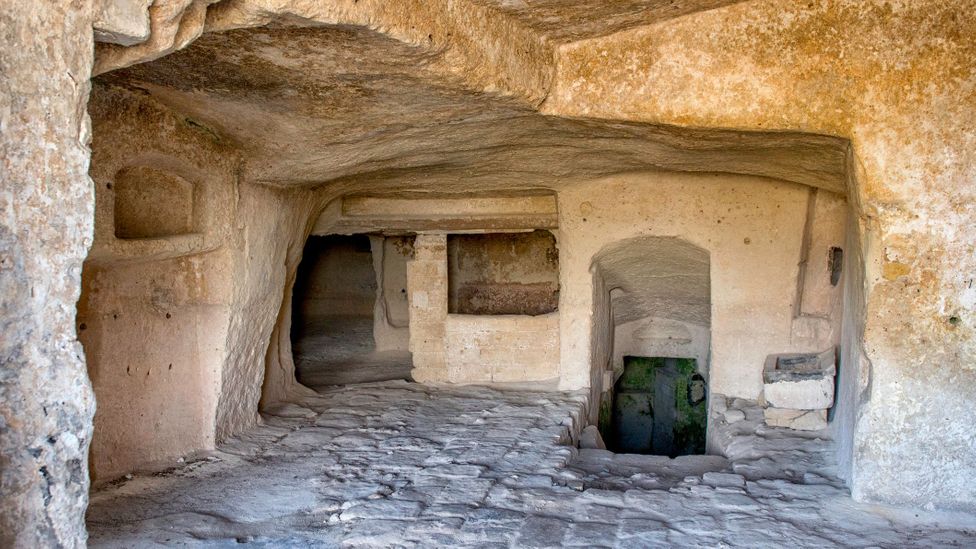
Sassi residents built stone homes that were conducive to the region's cool winters and hot summers (Credit: Bobbushphoto/Getty Images)
And according to Rita Orlando, an architect who works as cultural manager for the Matera Basilicata 2019 Foundation, residents were mostly vegetarian. "This is a peculiarity of farming culture. Meat was quite expensive, and the majority of people couldn't afford it except on special occasions. Legumes were a significant source of protein," she said.
Residents maintained a community-oriented, circular approach to life. Materials and objects were repaired, reused and repurposed many times, said Orlando, and there was a strong sense of community based on mutual support. A good example of how the people worked together was a ritual that took place each August: "The Sassi inhabitants cooked crapiata, a mix of legumes collected from all the families in the neighbourhood," she said. "It was a way not to throw away the unused legumes which were not sufficient for a family, but by pulling everyone's small quantities together, they could all share in the benefits."
For these reasons, the old stone settlement is often cited by contemporary urban planning experts as a prime example of a sustainable, "smart city". And why, in 1993, Unesco included the Sassi of Matera as a World Heritage site, calling it "the most outstanding, intact example of a troglodyte settlement in the Mediterranean region, perfectly adapted to its terrain and ecosystem".
The discovery under the flowerbed in Piazza Vittorio Veneto, which proved to be the subterranean Palombaro Lungo, was just another example of that sophistication. Likened to a "cathedral of water", the 16th-Century cistern, which measures 16m in depth and 50m in length, had the capacity to hold up to five million litres of fresh spring drinking water from the clay hills just west of the city.
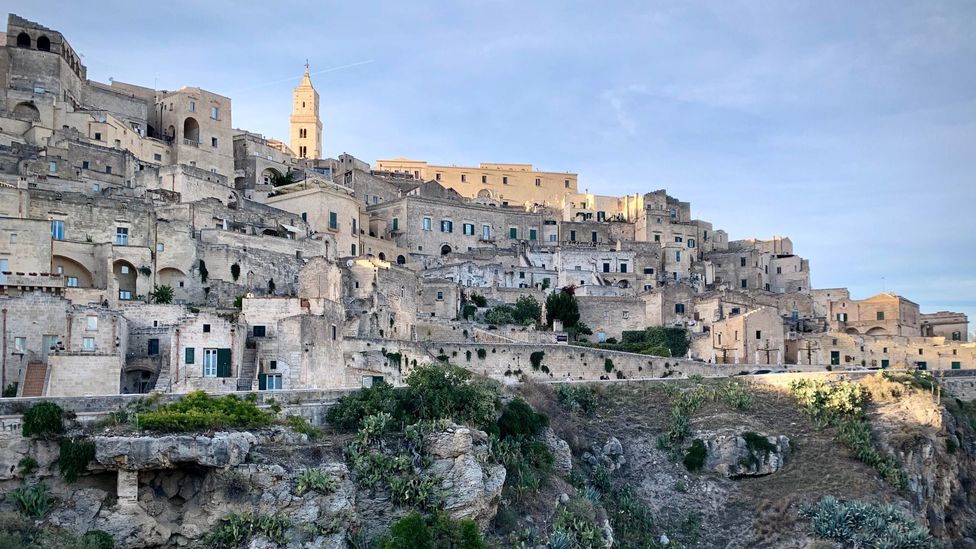
The old stone settlement is often cited as a prime example of a sustainable "smart city" (Credit: Elizabeth Warkentin)
The morning after meeting Nicoletti, I toured the Sassi with historian and guide Francesco Foschino, who is also the publisher of Mathera, a history magazine about the city and province of Matera. We stood on a narrow cobblestone street in Sasso Caveoso, one of the three stone neighbourhoods of the old town, leaning on a ledge looking out over the city.
Today, much of the Sassi area has been converted into luxury boutique cave hotels, trendy restaurants, art galleries, a contemporary sculpture museum and artist studios. Yet, the physical appearance of the Sassi district has changed little since before it was evacuated.
To the north and east, across the Gravina gorge, the desolate, pockmarked Murgia plateau stretched out before us. To the west, interconnected honeycombs of sandstone-hued stone dwellings, Byzantine rupestrian churches, and caves four or five levels deep formed the upper part of the old city. A labyrinth of stairways and narrow streets connected the different levels.
Sassi architecture is subdivided from the top of the limestone rock to the bottom, along terraces connected by stairs
"Sassi architecture is subdivided from the top of the limestone rock to the bottom, along terraces connected by stairs," Sabrina Centonze, an architect specialising in low-impact housing, later told me. "Here, the roof of one cave is the floor of the cave above. It's called 'architecture by subtraction', as the construction proceeds by subtracting material from the earth."
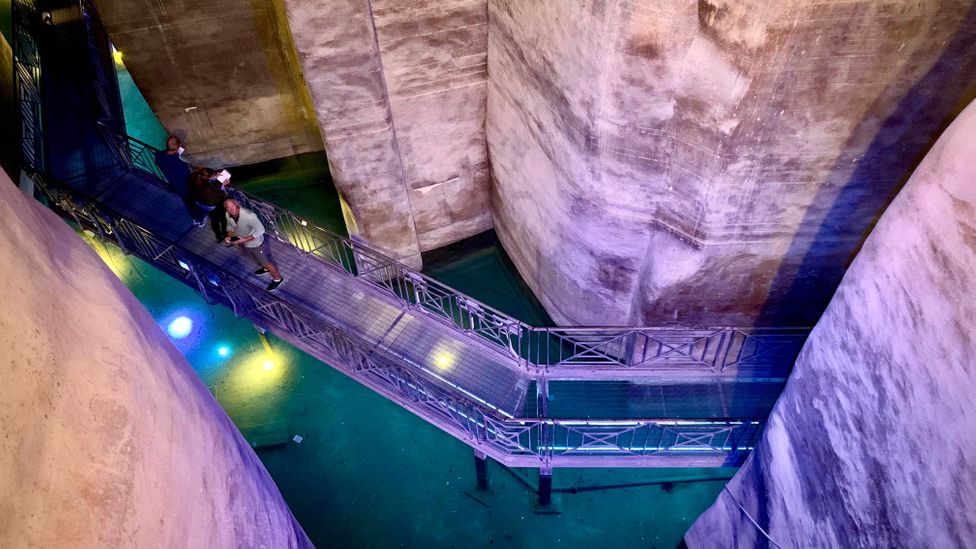
The Palombaro Lungo is a manmade 16th-Century cistern that can hold up to five million litres of drinking water (Credit: Elizabeth Warkentin)
After marvelling at the ingenious architecture, Foschino and I headed to the cavernous Palombaro Lungo. To get a sense of its vast proportions, we clambered up and down steel staircases and along footbridges, admiring the 16m-high stone walls above us and the illuminated tourmaline-green water below.
We also stopped at Fontana Fernandea, a public fountain at one end of Piazza Veneto. Dating to the Middle Ages, the fountain is simple, with little adornment. Like the Palombaro, its true purpose was to provide citizens with fresh spring water for drinking.
Perhaps the most awe-inspiring water-collection systems were the private ones found in almost every home in the Sassi. Each of these homes had gutters carved out of limestone, small clay canals or pipes laid outside to funnel water into the home. Inside, meanwhile, they'd dug water collection cisterns and water filtering tanks of different sizes. Rainwater was filtered for hygienic reasons but was not meant for drinking.
Foschino told me that he's irritated by the perception of Matera as an inferior society. When he thinks of the international headlines of the 1950s that screamed, "In Matera, people are still living in caves", he becomes especially annoyed. "It's this word 'still'," he said, "as if they were living like cavemen of the Neolithic age."
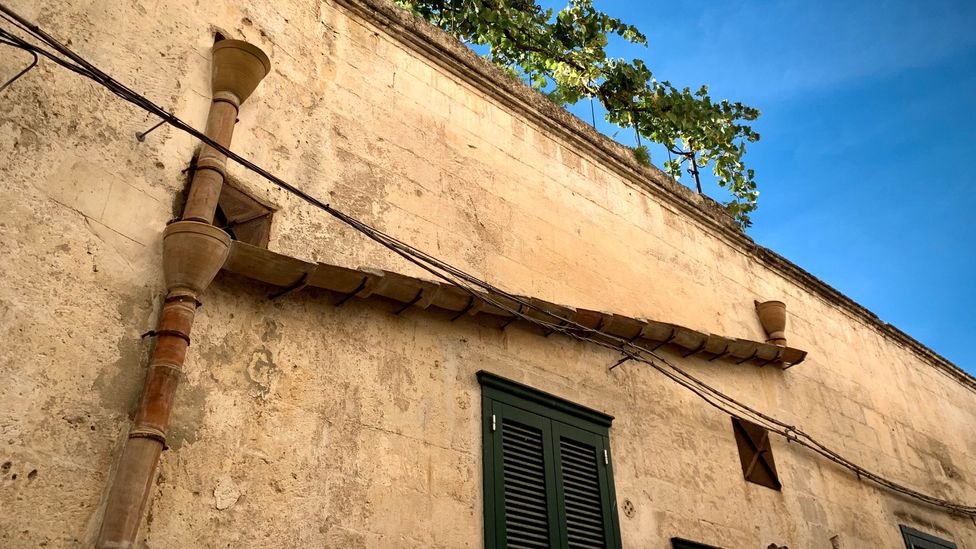
Sassi homes were cleverly designed with small clay canals or pipes to funnel water inside (Credit: Elizabeth Warkentin)
What's more, this view is only part of the picture.
When the word 'cave' is used in Matera, locals always mean man-made caves, not natural caves. This is the source of a lot of misunderstandings
"Sasso means 'stone' in Italian," said Foschino. "But in Matera, sasso means a district with buildings and caves." When the word 'cave' is used in Matera, locals always mean man-made caves, not natural caves. "This is the source of a lot of misunderstandings."
Foschino stressed that caves were never intended for human habitation; they were excavated from behind stone buildings to store food and produce olive oil, wine and cheese.
Matera's downward trajectory began when the capital of Basilicata was moved from Matera to Potenza in 1806. Then, as a result of the Industrial Revolution, the caves behind peoples' homes, once a source of wealth, became useless. With Italy's unification in 1861, the agricultural fields previously owned by the Catholic Church were confiscated, forcing the tenant farmers to move to the Sassi district of Matera. With the caves no longer needed for food storage or production, and the farmers needing shelter, the Materani rented their caves to these newly homeless families.
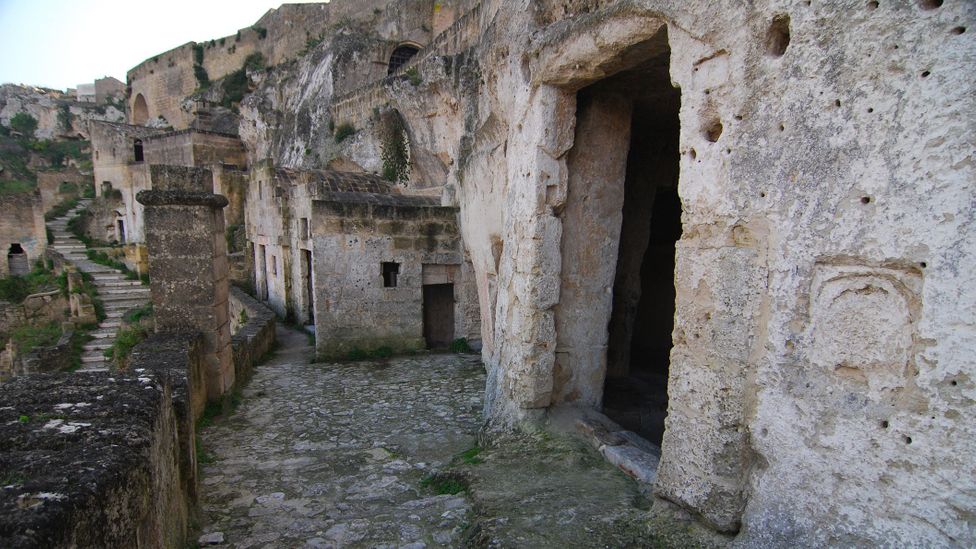
Inhabited since the 9th Century, the Sassi district was finally evacuated in the 1950s (Credit: Michele D'Amico supersky77/Getty Images)
The city soon became overpopulated. "To create more space in the caves to house more tenants, they dug deeper into the rock, breaking into the filtering cisterns," said Nicoletti. Inevitably, this impacted the purity of the rainwater. Hygiene declined, leading to illness and death.
"There was a high rate of infant mortality," said Nicoletti, "but this was happening all over southern Italy. My father, who lived in the Sassi until he was 20, lost three brothers who died when they were under three years old."
Despite widespread deprivation in southern Italy in the 1950s, Matera became the global showcase for the Italian government and the US Marshall Plan, whose leaders wanted to illustrate how a community "still living in caves" could be rescued from destitution by depositing it into suburban modernity.
Yet if Matera is a showcase for anything, it is as a model of ingenuity and resilience. Its era of abject hardship "was only a parenthesis" in Matera's long and storied existence, said Nicoletti.
"This is not a land of poverty," he continued. "We have more than 150 rock churches with stunning frescoes. We were European Capital of Culture in 2019. We have great art installations. And we developed a unique way of living sustainably."
---
Join more than three million BBC Travel fans by liking us on Facebook, or follow us on Twitter and Instagram.
If you liked this story, sign up for the weekly bbc.com features newsletter called "The Essential List". A handpicked selection of stories from BBC Future, Culture, Worklife and Travel, delivered to your inbox every Friday.
